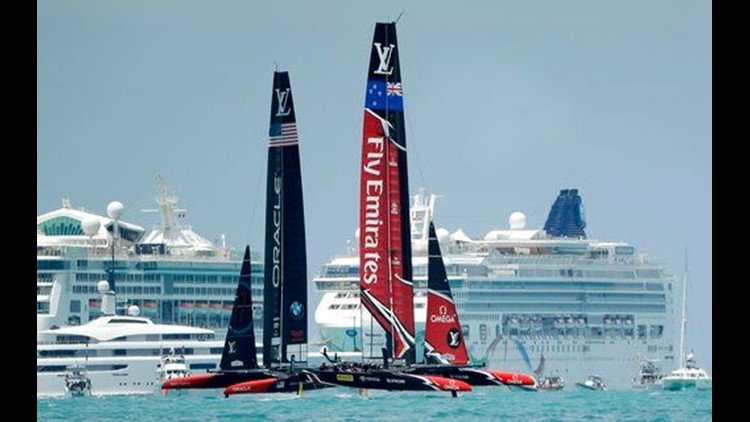SAN DIEGO (AP) — The America's Cup is ditching fast, foiling catamarans in favor of 75-foot monohulls with crews of 10 to 12 governed by a stricter nationality rule than in recent regattas.
America's Cup champion Emirates Team New Zealand and the Challenger of Record, Italys' Luna Rossa Challenge, announced the protocol for the 36th America's Cup on Friday morning in Auckland, with more specifics to come during the next several months.
Among them are the design of the new class and whether the boats will foil. So far, the AC75 is promised only to be a "high performance" boat. AC75 Class concepts are due to be released Nov. 30 and the class rule is set to be published on March 31.
Regardless of what the boat looks like and how it sails, the Kiwis are returning to tradition in the 166-year-old competition.
Team New Zealand Grant Dalton CEO said the main reason for the switch back to monohulls was "to attract more quality challengers to the event. ... We think the greater sailing community relates more to a monohull."
While Team New Zealand has been the primary driver in the technology of foiling multihulls, "We really like the opportunity to make sure that we can put that emphasis now into monohulls and to bring them up to that same level over a period of years."
The last time monohulls were sailed in the America's Cup was 2007. They were plodding compared to the multihulls that sailed in the last three regattas.
In 2010, a bitter court case between billionaires led to a one-off showdown in which American tech tycoon Larry Ellison's Oracle Team USA sailed a massive trimaran to victory over Alinghi of Switzerland's equally huge catamaran. Ellison and his top sailing lieutenant, Russell Coutts, then forged on with their vision to modernize the Cup by sailing it in catamarans.
The 2013 America's Cup on San Francisco Bay was sailed in 72-foot cats with crews of 11, although it attracted only three challengers. The 2017 America's Cup was sailed on Bermuda's Great Sound in 50-foot catamarans with crews of only six. Team New Zealand emerged from the fleet of five challengers and stunned Oracle Team USA in the match.
Traditionalists have grumbled about the lack of tactics and that most of the crew were grinders providing power to run the hyrdraulics that controlled the wing sail and daggerboards that were tipped with hydrofoils.
Dalton said cost containment in the protocol is important, but that teams will spend what they want. Personnel makes up the biggest part of team budgets, and increasing crew size will increase costs.
"If any team knows about cost containment it's this team," Dalton said, referring to the Kiwis routing Oracle despite a limited budget. "However, this is the America's Cup and it still needs to be at the forefront. If we dumb it down too much it won't be at the forefront."
Twenty percent, or three crew, whichever is higher, must be true nationals, while the rest of the crew must live in the country of a challenging yacht club for a minimum of 380 days during a two-year period between September 2018 and Aug. 31, 2020.
The challenger trials and 36th America's Cup match are scheduled for early 2021, as close to Auckland as possible but not on the city's inner harbor.
If a host city agreement can't be negotiated, or if something unforeseen occurs, the regatta will be held in Italy.
The fashion house Prada, which backs Luna Rossa, will be the naming and presenting sponsor of all events. The Challenger Selection Series will be called the Prada Cup. Patrizio Bertelli, head of Luna Rossa Challenge, is CEO of Prada.
Luna Rossa pulled out of the 35th America's Cup in a dispute over an unprecedented midstream downsizing of boats. However, it helped the Kiwis with technology and manpower.



